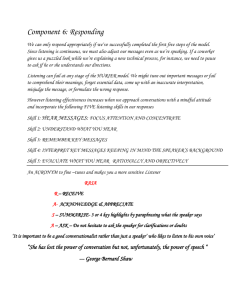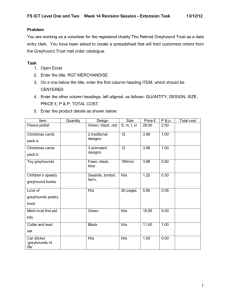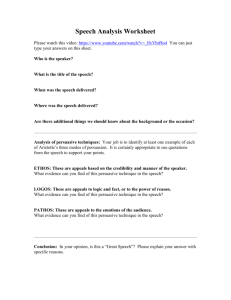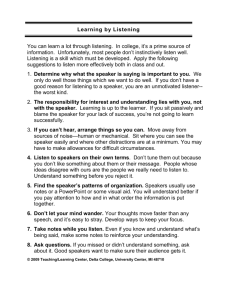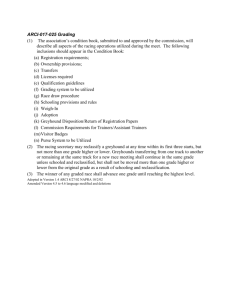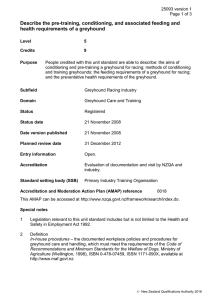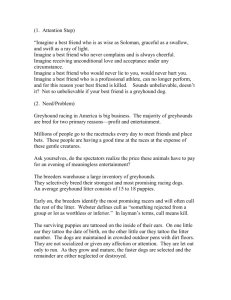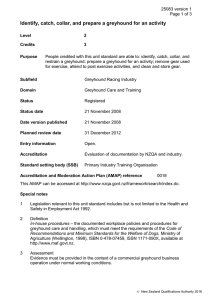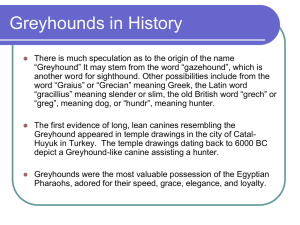Final Exam Study Guide – Communication Applications Spring 2014
advertisement
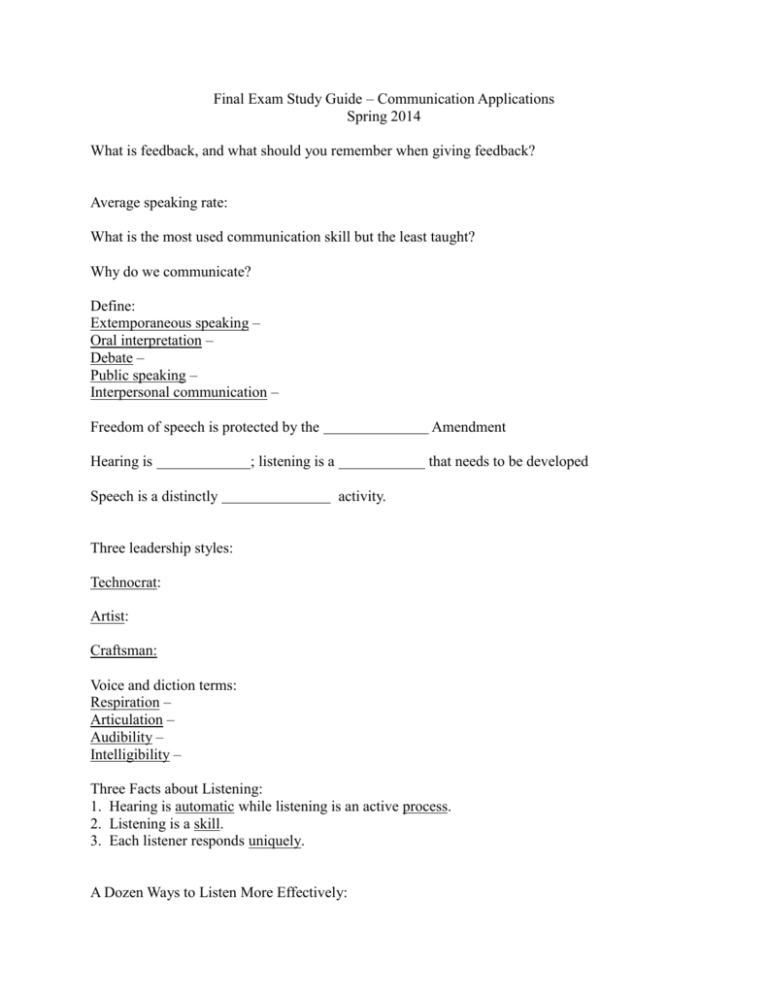
Final Exam Study Guide – Communication Applications Spring 2014 What is feedback, and what should you remember when giving feedback? Average speaking rate: What is the most used communication skill but the least taught? Why do we communicate? Define: Extemporaneous speaking – Oral interpretation – Debate – Public speaking – Interpersonal communication – Freedom of speech is protected by the Amendment Hearing is that needs to be developed Speech is a distinctly ; listening is a activity. Three leadership styles: Technocrat: Artist: Craftsman: Voice and diction terms: Respiration – Articulation – Audibility – Intelligibility – Three Facts about Listening: 1. Hearing is automatic while listening is an active process. 2. Listening is a skill. 3. Each listener responds uniquely. A Dozen Ways to Listen More Effectively: 1. Stop talking. 2. Put the sender at ease. 3. React appropriately. 4. Concentrate on what is being said. 5. Get rid of distractions. 6. Don’t give up too soon. 7. Avoid making assumptions. 8. Don’t argue mentally. 9. Listen for main points and supporting evidence. 10. Share responsibility for the communication. 11. Ask questions. 12. Use active listening: Restating what you thought the speaker has said before going on. Four components of listening: Four types of listening: 10 Types of nonverbal communication: (know definitions) 1. Kinesics – 2. Affect display – 3. Haptics – 4. Artifactual – 5. Proxemics – 6. Chronemics – 7. Paralanguage – 8. Silence – 9. Physical attractiveness – 10. Environment – Communication Barriers – “Glory Road” 1. Gender – discrimination; stereotyping because of difference in gender 2. Cultural – no knowledge of another’s cultural (way of life, religion, ways of speaking, music, food, etc.) make it difficult to communicate 3. Status – one thinks he/she is better than another because of ability, social position, money 4. Racial – discrimination; stereotyping due to color of skin or nationality 5. Geographical – no knowledge of type of physical environment presents problems (i.e. north v. south, country v. city) 6. Fear – intimidated by another or group 7. Education/knowledge – no knowledge of or little knowledge of a particular subject 8. Age – the idea that someone of a different age doesn’t have any knowledge of a subject, or is inferior, or can’t relate to you Preparing to give a speech Three main parts of a basic pattern of a speech – Most common type of speech – Types of organization of a speech – Chronological – Spatial – Order of importance – Cause and effect – Difficulty method – Problem to solution – Topical approach – Supporting materials – Facts – Statistics – Descriptions – Definitions – Quotations – Comparison and contrast – Restatement – Visual aids – Reinforcement – Demonstrations – Visual aids should not be passed around because – Visual aids and demonstrations – a. b. c. d. Stage Fright Fear of appearing on stage (i.e. doing presentations in front of an audience) Physical changes that occur because of stage fright – upset stomach; dry or wet mouth; extra perspiration; trembling The speaker him/herself often notices his/her own nervousness the most Use of a small note card during a speech rather than a piece of paper is best because: memorize more, read less; not as distracting; won’t move as much if speaker is nervous/trembling Interviewing Resume’ – What is the interviewer’s job? - Who is an interviewee? List the 10 ways to BOMB a job interview: 1. 2. 3. 4. 5. 6. 7. 8. 9. 10. What are some traditional (4) resources for a job search? List the pointers given about preparing a resume’: What information should a resume’ contain? References – What should a follow-up letter include (4)? Researching the organization – What are two reasons for researching a company before going to an interview? 1. 2. Magnum Opus (“Great Work)/persuasive speech What are the five (5) main parts of a persuasive speech and what is each one’s function? 1. Attention step: where speaker tries to establish a rapport with the audience to get the members to pay attention and want to listen to the speech. 2. Need step: the longest step, should take at least two (2) minutes, and states the problem clearly. 3. Solution step: tells the audience exactly what needs to be done to correct the problem. 4. Visualization step: most important step; goes farther than the solution step because it shows the audience that the solution will work because someone/some organization is taking the action right now that the speaker wants us to take. 5. Challenge step: dare, straw man, and frame/link to the introduction are powerful motivators in this step. Ten Motive Appeals (used in persuasive speeches to get audience members to take action) (The examples given are from the Greyhound Dog Racing/Greyhound Adoption speech attached to your persuasive speech outline and packet) 1. Self-preservation- the desire to live. A death reference is very persuasive. Example: “Cull means kill.” “Over 50,000 greyhound dogs were killed this year!” 2. Pride- feeling of personal worth or accomplishment. We don’t like to feel inferior or to be made fun of. We want the best. Example: “the strongest, most promising racing dogs…”“He had been a champion…” “I wasn’t just looking, I was adopting.” “We couldn’t have chosen a better breed…” 3. Personal enjoyment- the desire for beauty, comfort, and recreation. Make your speech fun. Example: “15-18 puppies” “friendly, beautiful greyhounds…” “I selected a small black and white female named Midnight…her favorite thing is to just lay down and curl up right next to you…” 4. Love and affection – the need to give and receive love, to have friends, to help the less fortunate. Example: “…Roy walked out dragging his bed with his raw hide bone. He dropped his bed next to Bill…ever since then, they have been inseparable.” “always eager to please the ones she loves…” 5. Acquisition and Saving – is an appeal to the pocketbook. Show me how you will save me money Example: “won hundreds of thousands of dollars in prize money.” “For as long as it is profitable, there will be greyhound races.” 6. Adventure and Curiosity- is an appeal for adventure, suspense. Dr. Broca discovered a part of our brain that acts as a gatekeeper. If it doesn’t arouse our brain, we will zone. Put in a “broca” moment. Example: “Imagine a best friend who is wise…never complains…would never lie to you…not so unbelievable if your best friend is a greyhound dog.” 7. Loyalty – is faithfulness to nation (patriotism), school (school spirit), city (hometown), family (honor). Example: “Midnight has been a part of our family for over 3 years now.” 8. Imitation – is a need to conform, to “go along with the crowd” in dress, hair styles, actions. Be like _____. Example: “The author of the article who was also a volunteer at the GPA, adopted Bill and brought him home to her seven other greyhounds.” 9. Reverence – is a desire to “look up” to someone. This respect can appear in three forms: a)hero worship or deep admiration for people such as a star athlete, a national hero, or a man in high office; b) tradition, or respect for observances such as wearing caps and gowns for graduation; c) Deity, or worship of a supreme being. Example: “The GPA has been placing retired racers in loving homes for many years.” “…a best friend who is as wise as Solomon…” 10.Creating- is the urge to invent and our urge to “do it yourself.” Example: “I’ve given you countless good reasons to adopt a greyhound. Can you give me one good reason not to?”
